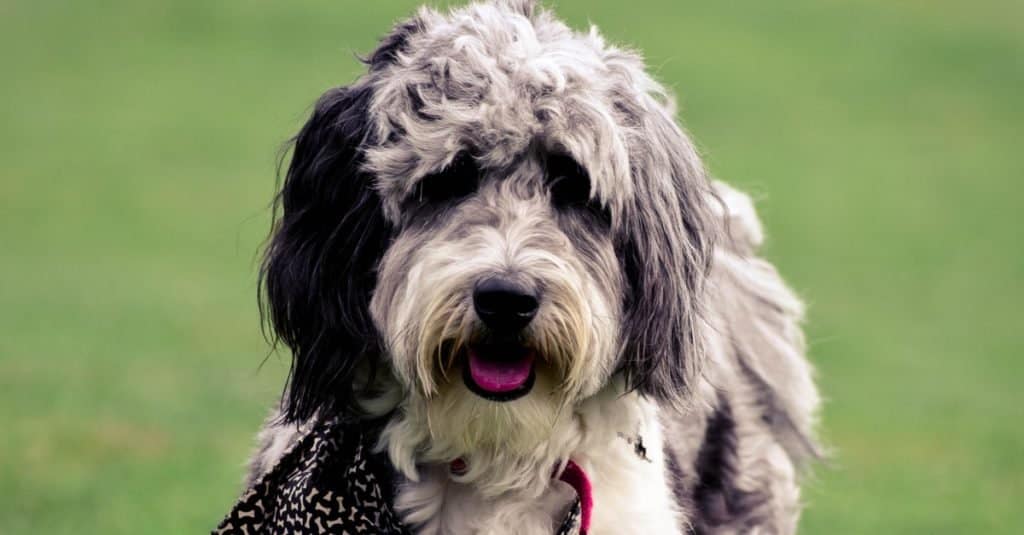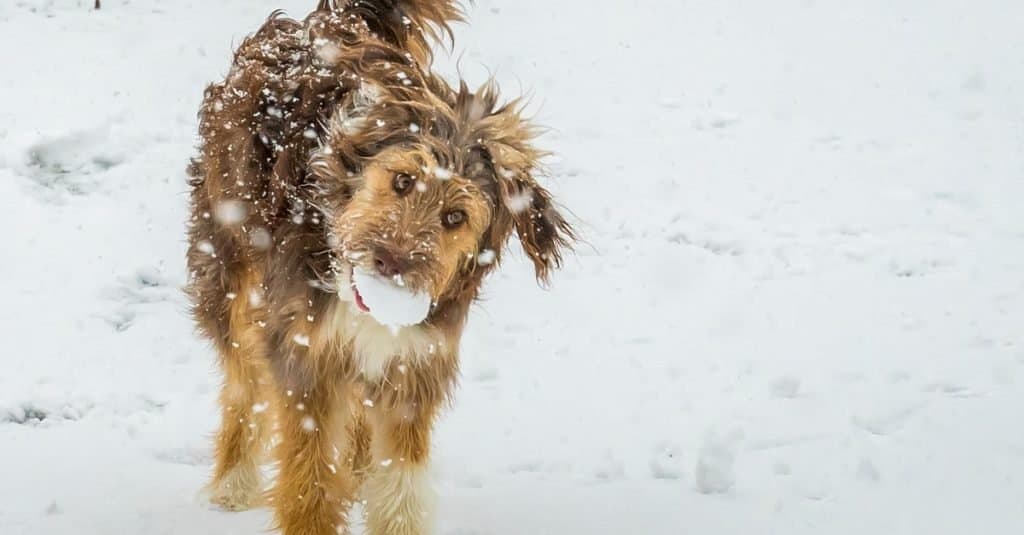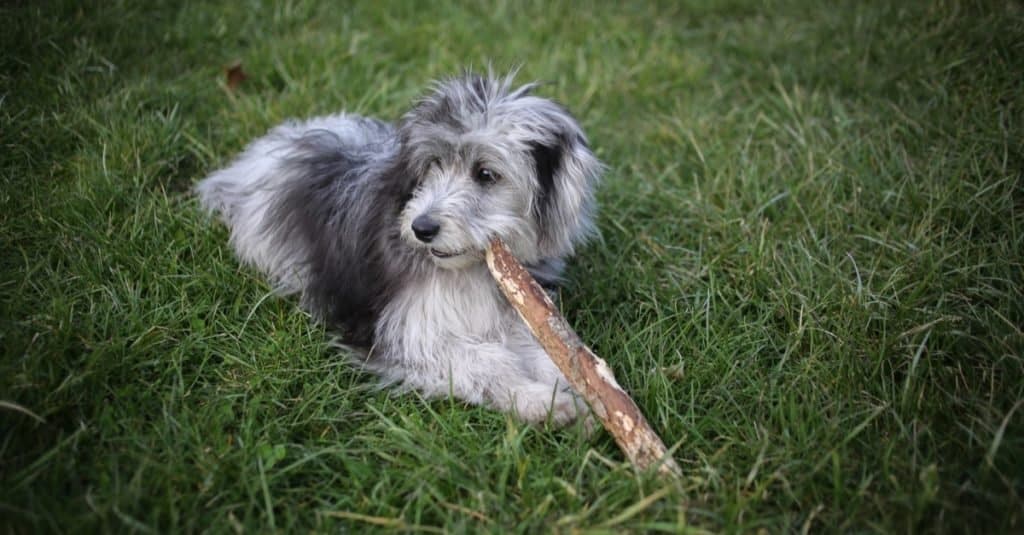The first of the Aussiedoodle facts, and probably the most important, is that this dog is a hybrid between the Australian Shepherd and a Poodle. The breed is relatively young, having only developed in the last two decades. And contrary to what their name suggests, breeders in the U.S. were the first to create Aussiedoodles.
Breeders first used Australian Shepherd parents imported to the States from Australia in the 1950s. The next step was to mate them with the Giant Poodle. And while both parents are purebred, kennel clubs worldwide do not recognize them as a breed. Because of their heritage, Aussiedoodles come in various sizes and are known by many names. Some of these names are the standard Aussiedoodle, the medium Aussiepoo or miniature Aussiedoodle, and the toy Aussiedoodle.

Steve Bruckmann/Shutterstock.com
Aussiedoodle Fact: They May Have A Gene That Affects Their Eye Color
Most Aussiedoodles have two eyes of the same color, even if the color isn’t the typical deep brown of most dogs. In contrast, some Aussiedoodles can have unusual eye colors such as hazel, golden, or light blue. Australian Shepherds are well known for their range of unique eye colors. These include green or even amber-colored eyes. Many have two different eye colors or heterochromia.
Heterochromia usually affects dogs (or other animals) when both parents carry the gene. Even if neither parent shows heterochromia signs, their offspring may present with two eye colors. Likewise, heterochromia can be central, segmental, or complete. As the descriptions suggest, central heterochromia refers to a different ring of color around the eye. Segmental heterochromia means only a portion of the eye has a different color. Complete heterochromia means the entire iris color differs from the other eye. This gene is linked closely to the one that affects coat colors, so dogs with heterochromia will also display unusual coat colors.

IK Photography/Shutterstock.com
Aussiedoodles May Have Congenital Eye Problems
Aussiedoodles are known for their beautiful coat and eye colors. The gene responsible for these colorations is congenital (inherited from the bloodline) and causes eye problems in many instances. Consequently, many Aussiedoodles can be born blind or have very thin irises. Other eye problems that this mixture experiences include iris coloboma. Iris coloboma is an abnormality that causes an indentation or partial split of the very edge of the iris. Aussiedoodles are also prone to developing cataracts, causing blindness. Eye problems can even occur in other areas of their eyes, potentially causing enormous problems for the Aussiedoodle and its owner.
Aussiedoodle Facts – They Can Be Sensitive To Ivermectin
Ivermectin is a medication used to treat heartworm or other parasites in dogs and cats. Some dog breeds, like collies and Aussiedoodles, may have an adverse reaction to Ivermectin, even at low doses. Some symptoms of an allergic reaction to Ivermectin include stomach upsets, vomiting, or even shock-like reactions.
No Aussiedoodle Looks The Same
Aussiedoodles vary a lot in appearance. So, while one Aussiedoodle may be large, another is small. A medium-sized Aussiedoodle may have straight hair like the Australian Shepherd. At the same time, the toy-sized Aussiedoodle can present with tight curls like the poodle. One pup in a litter may have a coat with wavy curls, while others have straight hair.
Aussiedoodle coat colors vary from grey to blue, fawn, black, and merle. It is also possible that Aussiedoodles can share their poodle parent’s coat colors, such as white, brown, peach, or red. These dogs are also one of the rare emerging dog breeds with a hypoallergenic coat. Hypoallergenic coats mean that they don’t do much shedding. Hence, people sensitive to animal dander are less likely to suffer allergies if they have Aussiedoodles as pets. And Aussiedoodle coats can present as curly like poodles or long like an Australian Shepherd and everything in between.

Peggy McClure/Shutterstock.com
Aussiedoodle Fact: They Make Great Therapy Dogs
Aussiedoodles are extremely perceptive dogs, and they love being around people. Their perceptiveness, in combination with their intelligence, makes them easy to train. So, because Aussiedoodles are so trainable, they make excellent therapy dogs. They are responsive to people with special needs, also making them exceptional emotional support and therapy dogs. This attribute is not surprising since Aussiedoodles are working dogs at heart. Consequently, using their innate desire to work will make them well-balanced, happy animals.
If You Neglect Their Training, They Can Become Neurotic
Australian Shepherds are herders, as their name suggests, while poodles have traditionally been used as retrievers. As a result of mixing these breeds, Aussiedoodles might display herding and retrieval instincts. For example, herding behavior might appear as nipping at heels, jumping, barking, and chasing. Aussiedoodles need a lot of training to curb this natural herding behavior. So, suppose you want one of these dogs as a pet. In that case, breeders recommend you start socialization and other training as soon as possible.

Steve Bruckmann/Shutterstock.com
Aussiedoodles Must Eat High Protein Food
Aussiedoodles are very energetic dogs. They require at least two hours of daily active play and training. Accordingly, Aussiedoodles need food high in protein and fat to grow and maintain their optimal weight. Pet owners should therefore look for high-quality foods containing all their necessary daily requirements, such as carbohydrates, minerals, and vitamins, in the right quantities. This nutrition must be available in addition to the protein and fat in pet food.
Aussiedoodles May Have Ear Problems

Holly Anne Cromer/Shutterstock.com
Aussiedoodles have long floppy ears with a significant amount of internal hair growth. This hair growth may cause problems like ear infections or dirty ears. Make sure to check your Aussiedoodle’s ears for dirt or infections regularly and take them to the vet to treat any condition as soon as possible. Clean their ears to periodically remove dirt and residue to keep their ears in good shape.
It’s A Fact That Aussiedoodles Love Water
Aussiedoodles love to play in the water, pool, and under sprinklers. They want to play in and with water as long as they can get wet. These dogs also enjoy swimming, so use this natural preference to give them the exercise they love so much. They will stay happy, and so will you.
Difficult To Find Aussiedoodles
Aussiedoodles are a ‘designer breed,’ specifically bred from two well-known species. Aussiedoodles have only been around as a breed for the past ten years or so. This fact makes them challenging to find. It also makes finding a well-known and reputable Aussiedoodle breeder extremely hard. Their rarity also makes finding one of these dogs in a shelter slim.
Up Next – More About Dogs
- Aussiedoodle
- Australian Labradoodle
- Best Dog Food for Goldendoodles: Reviewed by Experts for 2022
- Glechon
- Australian Shepherd Lifespan: How Long Do Australian Shepherds Live?
The post 10 Incredible Aussiedoodle Facts appeared first on AZ Animals.
from Animal News, Facts, Rankings, and More! - AZ Animals https://ift.tt/ejTJKVg